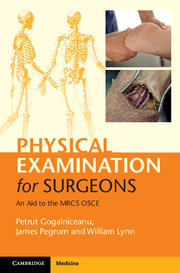Book contents
- Frontmatter
- Dedication
- Contents
- List of contributors
- Introduction
- Acknowledgments
- List of abbreviations
- Section 1 Principles of surgery
- Section 2 General surgery
- 3 Examination of peripheral stigmata of disease in general surgery
- 4 Examination of the abdomen
- 5 Examination of abdominal scars
- 6 Examination of the groin
- 7 Examination of a stoma
- 8 Renal access and transplant examination
- Section 3 Breast surgery
- Section 4 Pelvis and perineum
- Section 5 Orthopaedic surgery
- Section 6 Vascular surgery
- Section 7 Heart and thorax
- Section 8 Head and neck surgery
- Section 9 Neurosurgery
- Section 10 Plastic surgery
- Section 11 Surgical radiology
- Section 12 Airway, trauma and critical care
- Index
8 - Renal access and transplant examination
from Section 2 - General surgery
Published online by Cambridge University Press: 05 July 2015
- Frontmatter
- Dedication
- Contents
- List of contributors
- Introduction
- Acknowledgments
- List of abbreviations
- Section 1 Principles of surgery
- Section 2 General surgery
- 3 Examination of peripheral stigmata of disease in general surgery
- 4 Examination of the abdomen
- 5 Examination of abdominal scars
- 6 Examination of the groin
- 7 Examination of a stoma
- 8 Renal access and transplant examination
- Section 3 Breast surgery
- Section 4 Pelvis and perineum
- Section 5 Orthopaedic surgery
- Section 6 Vascular surgery
- Section 7 Heart and thorax
- Section 8 Head and neck surgery
- Section 9 Neurosurgery
- Section 10 Plastic surgery
- Section 11 Surgical radiology
- Section 12 Airway, trauma and critical care
- Index
Summary
Checklist
WIPER
• Patient supine. Expose both arms completely, as well as chest and abdomen.
Physiological parameters
General
• Fluid status: shortness of breath, audible crackles, dry mucous membranes, facial oedema, peripheral oedema, cyanosis
• Clinical features of immunosuppression or chronic steroid use
Inspection
Arm fistulas:
• Radiocephalic fistula (wrist)
• Brachiocephalic or brachiobasilic fistulas (antecubital fossa)
• Prosthetic straight or loop grafts (PTFE)
Fistula complications:
• Non-functioning/thrombosed fistulas
• Haematomas or ecchymosis from needling
• Aneurysmal changes: tight or shiny skin
• Hand ischaemia from fistula: steal syndrome or embolization
Neck and chest (subclavian and internal jugular veins):
• Raised JVP (fluid overload)
• Dilated neck veins: central vein stenosis from long-term central dialysis lines
• Temporary non-tunnelled haemodialysis intravenous catheters (VasCath)
• Long-term tunnelled haemodialysis intravenous catheters (PermCath)
Abdomen:
• Peritoneal dialysis (PD) catheter
• Scars: nephrectomy scars in flanks, midline scars for PD catheters, suprapubic catheter scars, iliac fossae scars for renal transplant (Rutherford Morison incision, ‘ hockey-stick ’ incision), laparoscopic scars for nephrectomy (donor)
Leg:
• Prosthetic PTFE loop graft.
Palpation
• Skin turgor: fluid status
• Fistula (if present): thrill or pulse, palpable stenosis
• Pulses (if fistula present): radial, ulnar, brachial, axillary, subclavian
• Abdomen:
• ascites
• peritonitis (if PD catheter present)
• ballotable masses (polycystic kidneys)
•iliac fossa masses (transplanted kidney)
Percussion
• Percuss any iliac fossa mass to confirm it is dull (kidney) rather than cystic.
Auscultate
• Fistula: bruit (continuous ‘ machinery ’ bruit)
• Chest: crackles, effusions (fluid overload)
To complete the examination…
• Examine groins (femoral lines) and lower limbs (fistulas and grafts).
Examination notes
What are the three most likely clinical scenarios?
1. End-stage renal failure patient on dialysis:
a. peritoneal dialysis
b. dialysis via fistula
c. dialysis via intravenous line
d. haemofiltration via intravenous line
2. Low-clearance patient approaching need for renal replacement with a fistula created in advance; still passes urine
3. Renal transplant patient:
a. transplant working: not on dialysis but on immunosuppressive therapy
b. transplant failed: recommenced dialysis; transplanted kidney may be in situ or removed
What are the basic history points that need to be established in assessing for fistula formation?
• Is the patient left- or right-handed?
- Type
- Chapter
- Information
- Physical Examination for SurgeonsAn Aid to the MRCS OSCE, pp. 84 - 88Publisher: Cambridge University PressPrint publication year: 2015



